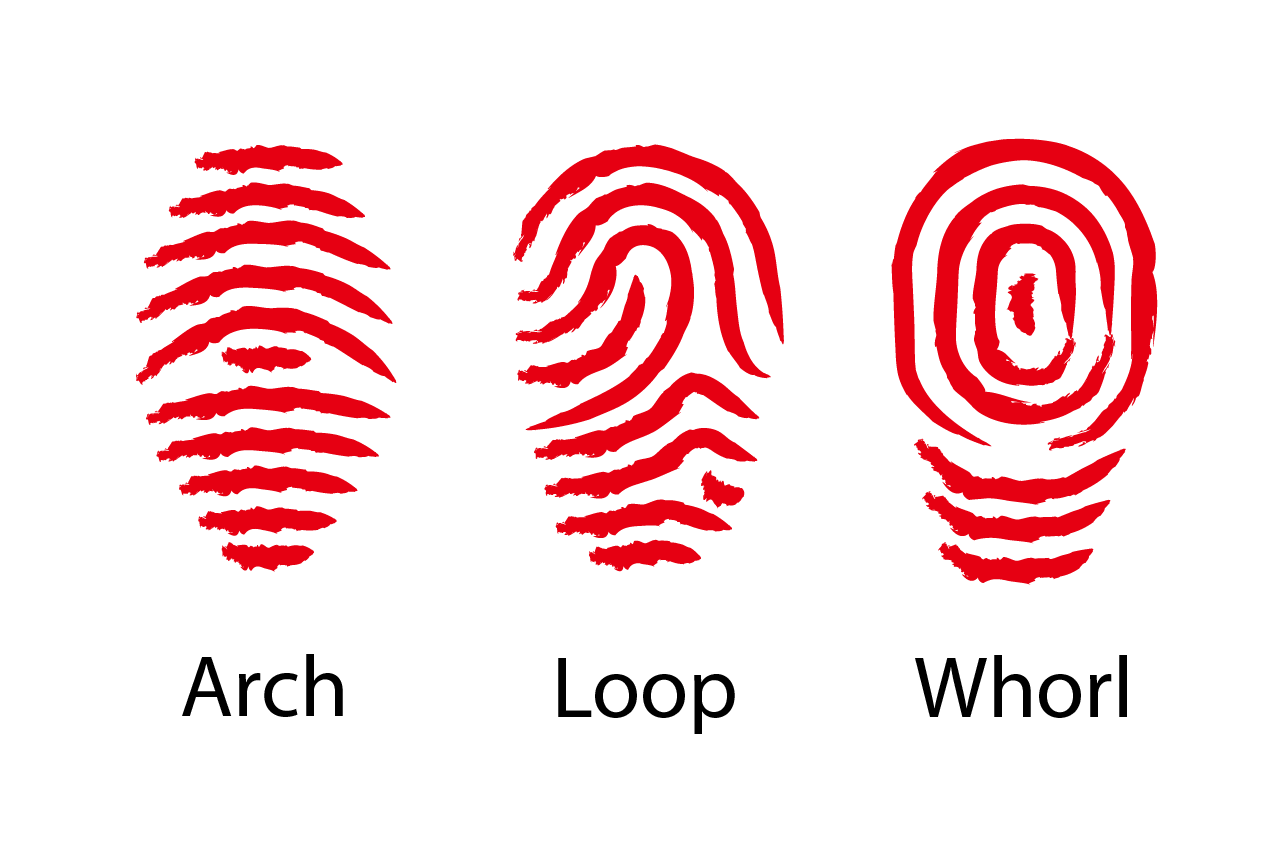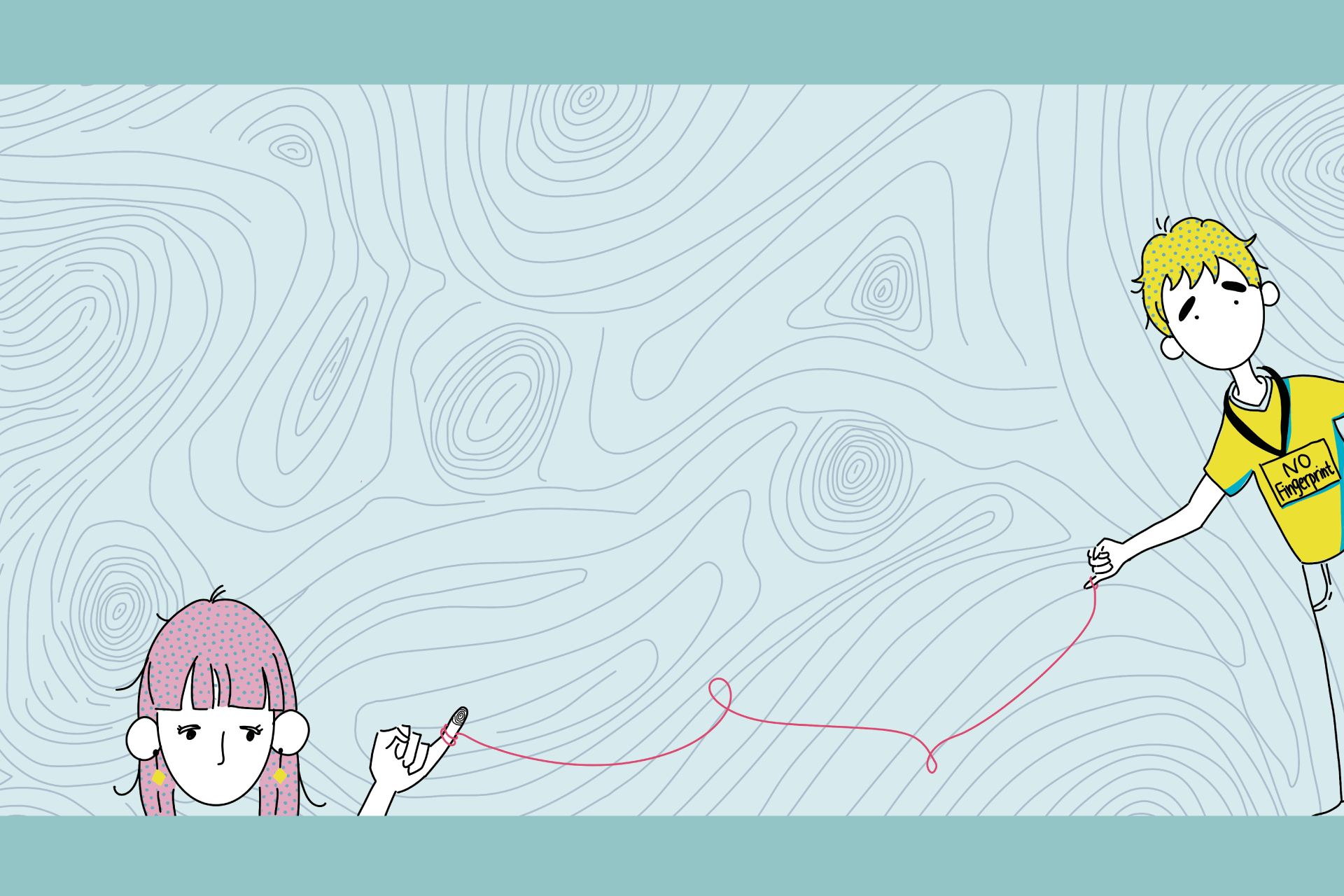Introduction
Before we delve into the complexities of blood tests and DNA analyses to identify who we are, society has already made a simple yet straightforward method that we always see in movies and when we are crossing the border: our fingerprints which are also known as "friction ridge skin". Just like our faces, fingerprints are key to our individuality and identity. But have you ever wondered why each of us has unique fingerprints? The answer lies deep in the interaction between our genes, especially those that control limb development, and the environment. This results in the formation of unique dermatoglyphic patterns which can be classified into three categories: arch, loop, and whorl (Fig 1).

Fig 1: The three categories of fingerprint: arch, loop and whorl
Fingerprint Formation
There are multiple theories supporting fingerprint development but dermatologists believe the folding hypothesis is the most promising one [1]. Skin tissue consists of three tightly connected vertical layers: epidermis, basal layer and dermis. The different rates of cellular growth in the top epidermis and the bottom dermis create a tension across the fast-growing basal layer, resulting in the folding of the basal layer at individual sites to relieve the stress (Fig 2) [2, 3]. Cell proliferation continues at those sites while the folds combine and merge into clusters to form linear ridges in a rather random fashion, creating the unique pattern of wrinkles in our fingerprints (Fig 3) [2].

Fig 2: Schematic diagram of the folding hypothesis [3]

Fig 3: Ridge formation through the combination of the centres of cell proliferation [2]
Volar pads are well known to play a role in determining fingerprint pattern. They are transient tissue swellings present on certain areas of our palms, including each fingertip, during embryonic development (embryogenesis) (Fig 4). Coinciding with the process of ridge formation, these structures start shrinking from the 10th week [1]. The shrinkage introduces extra mechanical stresses across the skin, affecting the directions of ridge formation [1]. Scientists generally agreed that the height and size of volar pads can influence the pattern of fingerprints [2, 4]. Whorl-type patterns are usually formed on high volar pads whereas low volar pads produce the arch-type pattern. Intermediate-height volar pads create the loop-type pattern.

Fig 4: Volar pads on the palm during embryonic development are highlighted in light gray.
Then, how do genetic factors come into play? It was illustrated that the geometry of volar pads can be controlled by genes [1]. For example, EVI1, a limb development gene responsible for the outgrowth of distal limbs and digits, was found to express under the volar pads. It was hypothesised to influence fingerprint pattern by controlling the shape and size of the volar pads through its function to promote cell proliferation, as in the distal ends of the developing limbs [4]. This also provides insight into the correlation between fingerprint pattern and limb-related phenotypes [4]. Researchers discovered that individuals with whorl patterns on both pinky fingers often have a longer pinky finger compared to those with no whorl pattern on pinky fingers; the frequency of whorl patterns on the fingers of both hands (except the thumbs) is also associated with longer pinky fingers [4].
Exception: The Family with No fingerprints
We have often taken fingerprint technology for personal identification for granted. Fingerprints are a huge part of our identity in modern society, with applications in mobile phones and immigration. Nevertheless, Apu Sarker's family in Bangladesh has no fingerprints due to a rare genetic mutation in the SMARCAD1 gene, causing Adermatoglyphia or "Delayed Immigration Disease" [5]. Luckily, it does not cause any serious illnesses, but the family encountered difficulties in their everyday lives because fingerprints became mandatory when obtaining driving licenses, sim cards, and passports. As a result, they could not obtain a driving license nor purchase a sim card for their mobile phones. In Apu's ID card when he was still 10, he was labeled with "NO FINGERPRINT" as the government officials had no idea on how to issue a card without the means for personal identification. With the advent of modern technologies, such as iris scan and facial recognition, let us all hope those who have such genetic conditions would not unintentionally be discriminated against in the near future.
Interesting Fact: Do Monozygotic Twins Share the Same Fingerprints?
Have you ever wondered whether identical twins share identical fingerprints? Although they are very similar in appearance and contain the same DNA sequence, they have slightly different fingerprints that are significant enough to be captured by the modern recognition software [6]. Aside from the randomness in the fingerprint formation process, small differences in umbilical cord length, womb position, blood pressure, nutritional intake, and the rate of finger growth during the 13th to 19th week can still influence fingerprint formation as a result [6]! This highlights the importance of how environmental factors apart from genetics also play an essential role in determining our fingerprints.
Conclusion
Our fingerprints are an important physical trait that can define who we are as individuals. The unique pattern formed during embryogenesis persists throughout our lives from the 19th week of gestation [3] and remains the same even after we die (until decomposition occurs). Its formation is dependent on the interaction between genetic and variable environmental factors, which ultimately give rise to our unique fingerprints: the key to our identity and individuality.
References:
- Kücken, M. (2007). Models for fingerprint pattern formation. Forensic Science International, 171(2-3), 85–96. https://doi.org/10.1016/j.forsciint.2007.02.025
- Wertheim, K. (2011). Embryology and Morphology of Friction Ridge Skin. In A. McRoberts (Ed.), Fingerprint Sourcebook (pp. 3-1–3-26). National Institute of Justice. https://www.ojp.gov/pdffiles1/nij/225323.pdf
- Garzón-Alvarado, D. A., & Ramírez Martinez, A. M. (2011). A biochemical hypothesis on the formation of fingerprints using a turing patterns approach. Theoretical Biology and Medical Modelling, 8, 24. https://doi.org/10.1186/1742-4682-8-24
- Li, J., Glover, J. D., Zhang, H., Peng, M., Tan, J., Mallick, C. B., Hou, D., Yang, Y., Wu, S., Liu, Y., Peng, Q., Zheng, S. C., Crosse, E. I., Medvinsky, A., Anderson, R. A., Brown, H., Yuan, Z., Zhou, S., Xu, Y., . . . Wang, S. (2022). Limb development genes underlie variation in human fingerprint patterns. Cell, 185(1), 95–112. https://doi.org/10.1016/j.cell.2021.12.008
- Sabbir, M. (2020, December 26). The family with no fingerprints. BBC News. https://www.bbc.com/news/world-asia-55301200
- Asher, C. (2021, September 18). Why do identical twins have different fingerprints? BBC Science Focus Magazine. https://www.sciencefocus.com/the-human-body/why-do-identical-twins-have-different-fingerprints-2/
Author: Charlton Sullivan, Student Editor, Science Focus, The Hong Kong University of Science and Technology
Design: Charley Lam, Graphic Designer, Science Focus, The Hong Kong University of Science and Technology
Translation: Daniel Lau, Managing Editor, Science Focus, The Hong Kong University of Science and Technology
December 2023

